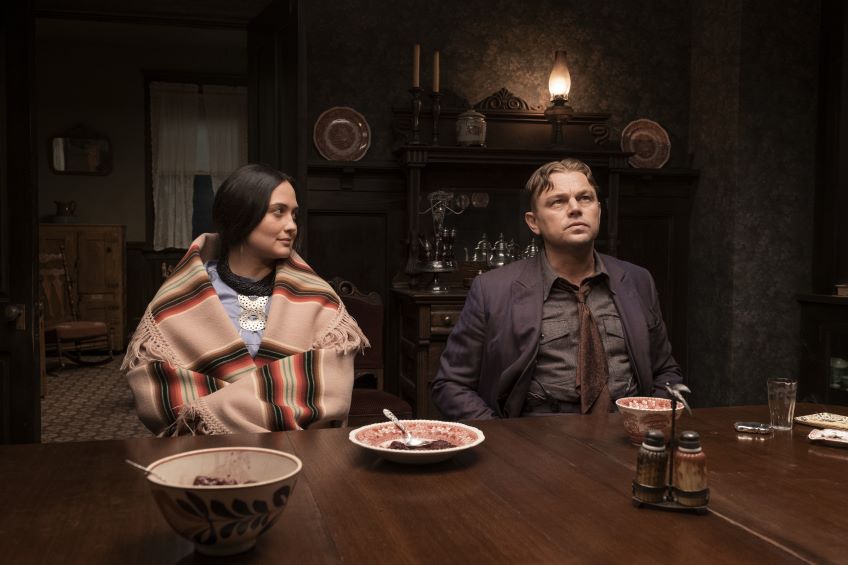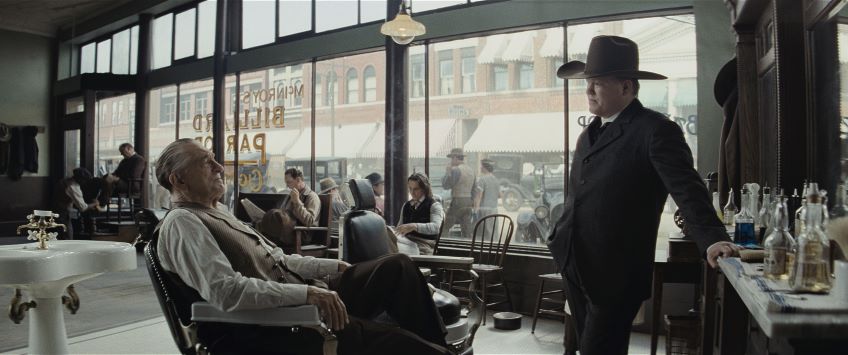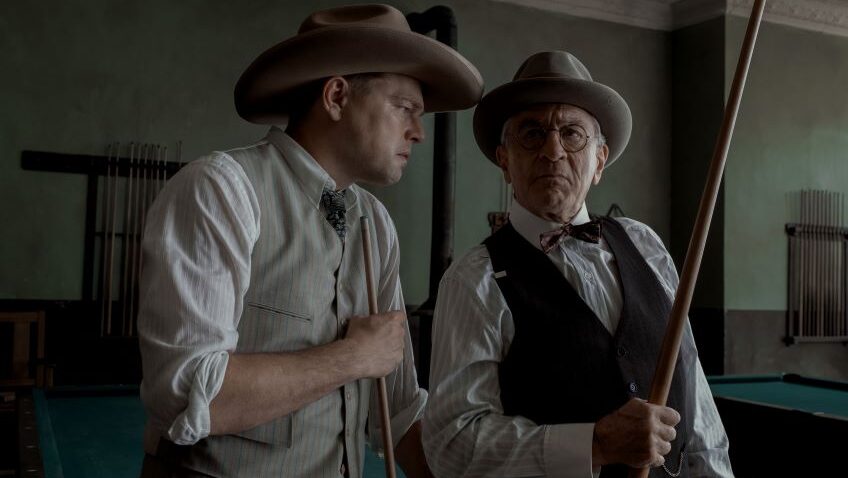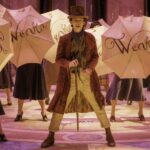Joyce Glasser reviews Killers of the Flower Moon (October 20, 2023) Cert 15, 206 mins. in cinemas
As Martin Scorsese turns eighty, he has a lot to celebrate, and the world has benefitted from his contributions to cinema as a director, a producer, a film historian and preservationist. Few would begrudge him another Academy Award for Best Director, and Killers of the Flower Moon ticks all the “Oscar” boxes, with its scope, its cinematography by Rodrigo Prieto, its location shooting, its cast – which includes many members of the Osage Nation – and its shocking historical subject matter. Scorsese has chosen a great story that graphically shows why American history must be rewritten. But Killers of the Flower Moon is not a great film and it’s a seriously flawed adaptation of David Grann’s harrowing masterwork.
Grann’s book investigated, chronicled and exposed, and Scorsese dramatises the plight of the Osage Native Americans after they were driven out of their land in Kansas in the 1870s onto presumably worthless land in northeastern Oklahoma. The story itself begins with an impressive panorama of miles of oil rigs in Gray Horse, Oklahoma, 1921, not far from the newer, larger settlements of Pawhuska and Fairfax. Beyond the rigs are hundreds of cattle and a prominent house on a small hill. The house belongs to controlling, duplicitous William King Hale (Robert De Niro). If at times this film reminds you of Let There Be Blood it could be because Jack Fisk, the production designer for that film, also set in the 1920s, is at work here.
Outside of town Osage native Mollie Kyle (Lily Gladstone, First Cow) lives comfortably with her ailing mother and servants. She does not drive but travels in taxis. She is about to meet a new taxi driver, Ernest Burkhart (Leonardo DiCaprio), and make him her chauffeur. Ernest, recently demobilised, is welcomed by his uncle, William King Hale, the most powerful and well connected white man in the county and sheriff of Fairfax.

Hale owns the county’s main store, a mansion and a huge cattle ranch. He commands respect in the area for he speaks the Osage Siouan language with displays of genuine solidarity with his Osage “brethren.” Note: Gladstone, DiCaprio and De Niro learned the language – or at least enough to speak in the Osage dialect.
This solidarity is needed as we see. After a short historic epilogue, the film opens on an Indian ritual carried out by the Nation’s elders in ceremonial attire. Something is rotten in the Osage Nation. Too many people are dying, especially from a “wasting illness.” Soon, the tribe votes to hire a private detective.
Mollie is particularly worried. She already has lost a sister and her mother is growing weaker every day. Mollie is reprimanded by her guardian for spending her own money on meat for her mother. Mollie herself is diabetic but it will take King Hale’s generosity, working with a brother-team of local doctors for her to be given the first insulin injections in the state. She, too, grows weaker despite her happy marriage with Ernest.
Uncle Hale hides his disappointment when he learns that Ernest worked as a cook and saw more men die of flu than combat in the war. Ernest, who has few prospects, asks for a drink and is quickly told that his uncle never drinks. Despite these draw-backs, Ernest is not a write-off. He is a white bachelor and in answer to his uncle’s surprising question, wouldn’t mind settling down with the right woman.
Terrific scenes in the chaotic, dusty busy town show that in the early twentieth century, members of the Osage Nation became the richest people per capita in the USA after oil was discovered. Suddenly the worthless land thrown to the Osage Nation became a new kind of killing field.

A law was established to help the Osage Nation retain their money so they did not gamble or drink it away. Every person inscribed on the Osage Roll reported to a white guardian, not necessarily a banker, to have access to their money.
The Osage people knew they were paying above the going rate in white men’s shops, and for these guardians, but money was plentiful and the only way for a white person to obtain “head rights” for the oil money was through marriage. That said, the Osage nation was as awash with mixed race marriages, as it was for abusive relationships. Bill Smith (Jason Isbell) is particularly sinister when, after his wife’s suspicious death, he married Mollie’s frightened sister, Rita (JaNae Collins).
It is in the wild west town of Gray Horse that Ernest offers Mollie his taxi and begins to flirt with her. As the relationship grows more serious, a giggling Mollie tells her friends, ‘he’s not too bright, but he’s handsome.’ Scriptwriter Eric Roth (Dune, Forrest Gump), co-writing with Scorsese, shows us that Hale had already calculated the benefits of a “not too bright” nephew marrying a full blood Osage woman.
There are many reasons to see this film – Scorsese’s only film working with muses De Niro and De Caprio together. One of them is DiCaprio’s nuanced and fascinating performance. Unfortunately, he had the star power to change around the whole adaptation and Scorsese, being partial to bad guys, gave way. Originally DiCaprio was to play the main character of the book, Tom White, a real-life Bureau of Investigation (the forerunner of the FBI) agent. Grann spends a sizeable percentage of the book describing White’s story and how, when J Edgar Hoover became head of the FoI in 1924, White was the most qualified, and trusted man to assume the Osage assignment. It was not necessarily doomed to failure but was extremely dangerous.
The full title of Grann’s book is: Killers of the Flower Moon: Oil, Money, Murder and the Birth of the FBI. In the book, Ernest is ubiquitous, but not fleshed out. By turning him into the main, flawed but sympathetic character, and giving Jesse Plemons’s Tom White a supporting role, Scorsese focuses on the oil and money, omitting entirely the fascinating parallel story of White and the birth of the FBI. He also omits the final section of the book in which Grann begins investigating where the FBI left off and suggests the real extent of the crimes against the Osage Nation.
This is far less important than Scorsese’s failure to instil in his adaptation the outrage we feel reading the book and its stomach-turning tension. The book, though non-fiction, is a nail biting suspense thriller and a whodunit. Incredibly, the movie is not. The casting and fleshing out of Hale and Ernest give away a lot of the suspense and the narrative plods on. We find ourselves struggling to remember the names (often mumbled) and match them to the faces of all the henchmen used to murder Osage natives by hand, fire, bombs, and guns. See the film. But read the book first.




